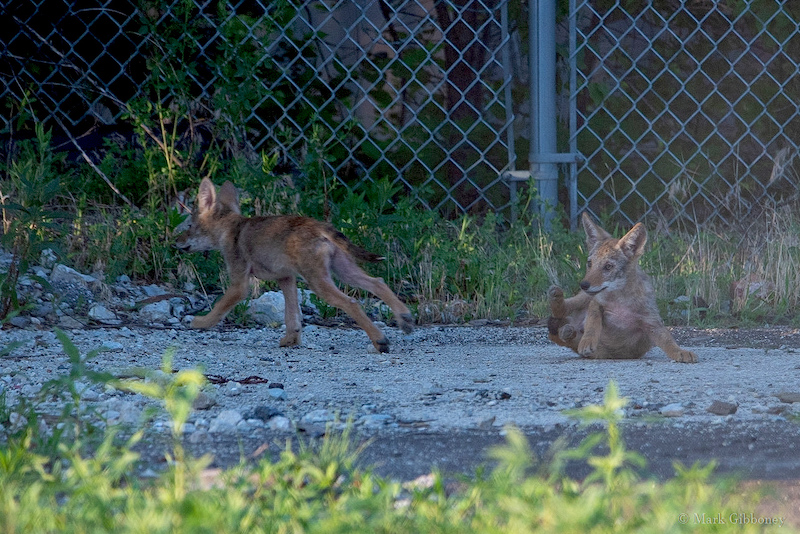
Photo by Jerry Kirkhart from Los Osos, Calif., CC BY 2.0, via Wikimedia Commons.
In Defense of Coyotes
Ask anyone what they think of coyotes, and you’re likely to get one of two replies: they’re dangerous or they’re a nuisance.
Admittedly, the coyote does have a shady reputation as a chicken coop-robbing, fawn-killing, garbage-eating, pet-snatching scoundrel, and those behaviors have been chronicled elsewhere – sometimes in mythic proportion. In the interest of balance, this story is about the side of the predator that some people actually admire.

- Coyotes have complex social dynamics. Some coyotes are solitary animals while others live in a group of closely related individuals, like siblings from previous litters who assist with the care of puppies. Some coyotes mate for life and co-parent their offspring with each helping to feed and raise their young. Other coyotes mate and go their separate ways.
- Coyotes have extensive communication skills. Described as one of the most vocal of all North American wild mammals, the coyote has a repertoire of more than 10 distinct calls, including growls, barks, yips, whines and howls – each having its own purpose. Along with scat placement and scent-marking to designate territory, and ear movement to indicate status and preference, the coyote is considered a sophisticated communicator in the animal kingdom.
- Coyotes control rodent populations. When it comes to dining preferences, coyotes consume whatever is abundant and easily acquired. That said, they enjoy a varied menu of mice, rats, chipmunks, insects, berries, carrion, fish, frogs, vegetation and whatever is available at the time. But examine a coyote’s diet, and you’ll find it prefers rodents. So, if you happen to see a coyote sleuthing around the dumpster, be grateful. It doesn’t necessarily want to eat your garbage. It might be waiting for the mice who visit your trash can.
- Coyotes are head-turners. Standing nearly 25 inches at the shoulder and between 3 to 4 feet long; with a thick variegated coat of brown, black and gray fur; large, erect ears; downward-pointing, black-tipped tail; and piercing yellow eyes, the coyote is a striking figure. It also enjoys keen vision, a strong sense of smell and can run up to 40 miles-per-hour. All that and they’re also very good swimmers! This is in direct contrast to the coyote’s characterization as a sneaky, slinking form.
- Coyotes are a native species. When Lewis and Clark encountered their first coyote in South Dakota in the early 1800s, they could not have known that this ‘new’ animal was already well-established throughout the plains. In fact, fossil evidence indicates that coyotes have been here for 10,000 years, perhaps longer. Not only are they a longstanding member of America’s natural history, they frequently appear in the stories of Native Americans who often characterized coyotes as intelligent and clever animals.
- Coyotes expanded their range with the aid of human activity. With the arrival of the first settlers, events were triggered that facilitated the coyote’s expansion throughout North America. Wolves and mountain lions were nearly eradicated, eliminating the coyote’s natural predators; trees were cleared for farms and ranches thus creating a highway for the coyote’s dispersal across the continent; and crops and livestock were introduced, providing the coyote with new options for food, water and habitat. Not surprisingly, the coyote expanded its range from coast to coast and from Canada to Mexico, while also taking up residency in nearly every urban setting. Whether on the streets of Chicago or in the grasslands of the rural countryside, the coyote has found a home that was unwittingly forged by human progress.
- Coyotes are resilient. According to Illinois’ most recent hunting and trapping records, over 94,000 (78,000 by hunting and 16,000 by trapping) coyotes were harvested during the 2020-2021 seasons. Together with hazing activities meant to scare them away with loud noises, the coyote is under constant pressure. Yet it persists. It has done so by adjusting its habitat, diet, breeding behavior and social structure so that it can survive.

So, while it’s tempting to characterize the coyote as either a threat or an asset, it’s really neither one. Rather, the coyote is a master adapter capable of adjusting to whatever the conditions demand. This is the behavior that has ensured its survival across thousands of years, and it is the behavior that will enable it to continue to co-exist alongside humans.
Carla Rich Montez is an Illinois Master Naturalist volunteering as a writer for OutdoorIllinois Journal. This story originally appeared on the website of the Chautauqua National Wildlife Refuge.

Submit a question for the author